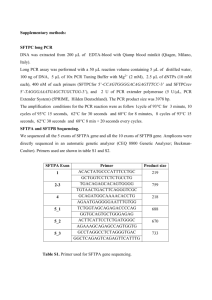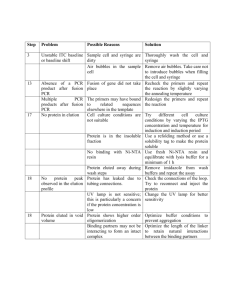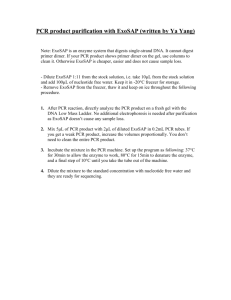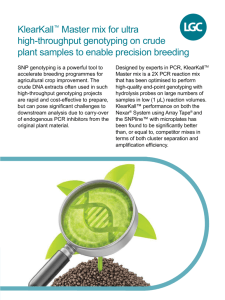Genotyping information
advertisement
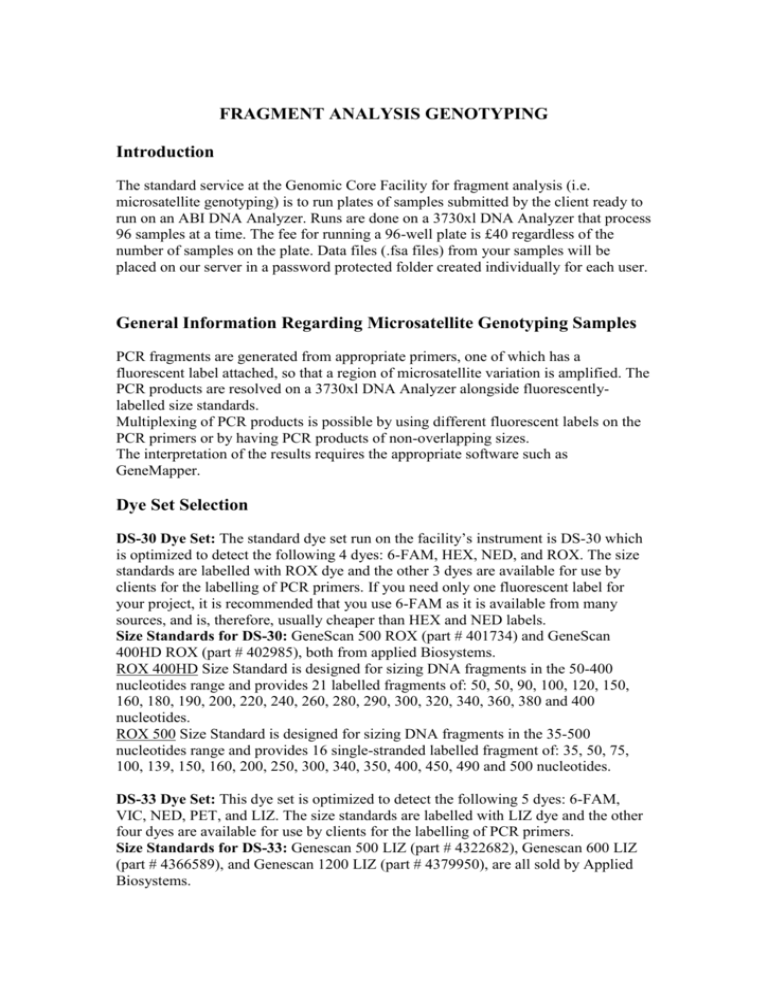
FRAGMENT ANALYSIS GENOTYPING Introduction The standard service at the Genomic Core Facility for fragment analysis (i.e. microsatellite genotyping) is to run plates of samples submitted by the client ready to run on an ABI DNA Analyzer. Runs are done on a 3730xl DNA Analyzer that process 96 samples at a time. The fee for running a 96-well plate is £40 regardless of the number of samples on the plate. Data files (.fsa files) from your samples will be placed on our server in a password protected folder created individually for each user. General Information Regarding Microsatellite Genotyping Samples PCR fragments are generated from appropriate primers, one of which has a fluorescent label attached, so that a region of microsatellite variation is amplified. The PCR products are resolved on a 3730xl DNA Analyzer alongside fluorescentlylabelled size standards. Multiplexing of PCR products is possible by using different fluorescent labels on the PCR primers or by having PCR products of non-overlapping sizes. The interpretation of the results requires the appropriate software such as GeneMapper. Dye Set Selection DS-30 Dye Set: The standard dye set run on the facility’s instrument is DS-30 which is optimized to detect the following 4 dyes: 6-FAM, HEX, NED, and ROX. The size standards are labelled with ROX dye and the other 3 dyes are available for use by clients for the labelling of PCR primers. If you need only one fluorescent label for your project, it is recommended that you use 6-FAM as it is available from many sources, and is, therefore, usually cheaper than HEX and NED labels. Size Standards for DS-30: GeneScan 500 ROX (part # 401734) and GeneScan 400HD ROX (part # 402985), both from applied Biosystems. ROX 400HD Size Standard is designed for sizing DNA fragments in the 50-400 nucleotides range and provides 21 labelled fragments of: 50, 50, 90, 100, 120, 150, 160, 180, 190, 200, 220, 240, 260, 280, 290, 300, 320, 340, 360, 380 and 400 nucleotides. ROX 500 Size Standard is designed for sizing DNA fragments in the 35-500 nucleotides range and provides 16 single-stranded labelled fragment of: 35, 50, 75, 100, 139, 150, 160, 200, 250, 300, 340, 350, 400, 450, 490 and 500 nucleotides. DS-33 Dye Set: This dye set is optimized to detect the following 5 dyes: 6-FAM, VIC, NED, PET, and LIZ. The size standards are labelled with LIZ dye and the other four dyes are available for use by clients for the labelling of PCR primers. Size Standards for DS-33: Genescan 500 LIZ (part # 4322682), Genescan 600 LIZ (part # 4366589), and Genescan 1200 LIZ (part # 4379950), are all sold by Applied Biosystems. How to Assemble your Genotyping Samples Materials * 96-well plate (part # THER-FA7) from Elkay-UK * HiDi Formamide (part # 4311320) from Applied Biosystems (NB. Other brands cannot be used) * Size Standard * Fluorescently labelled PCR products Method 1. Depending on the number of samples you are running, make up a Formamide-Size Standard master mix using the following volumes: 10uL HiDi Formamide per well 0.12uL of 500LIZ per well; or 0.3uL of 500 ROX or 400HD ROX per well 2. Put the appropriate amount of PCR product in the well (or multiple PCR products if you are multiplexing). The amount of PCR product needed will vary for each primer set: 1uL or less should give an appropriate signal but the amount should really be determined by test runs if you have no prior experience with a given primer set. This will help you determine how much to use to get an optimal signal. It is often helpful to run individual PCR products before multiplexing large number of samples together if you are not familiar with what intensities the PCR products will generate. When you are evaluating peak signals using GeneMapper: around 1000 is ideal, below 200 is getting weak, and above 12000 is too high and will cause secondary pull-up peaks. 3. Add 10uL of the Formamide-Size Standard master mix to the PCR product(s). It is also helpful to have one or more wells that contain only Formamide-Size Standard master mix to act as a control. If possible, wrap plates in foil to avoid any unnecessary exposure to light.





